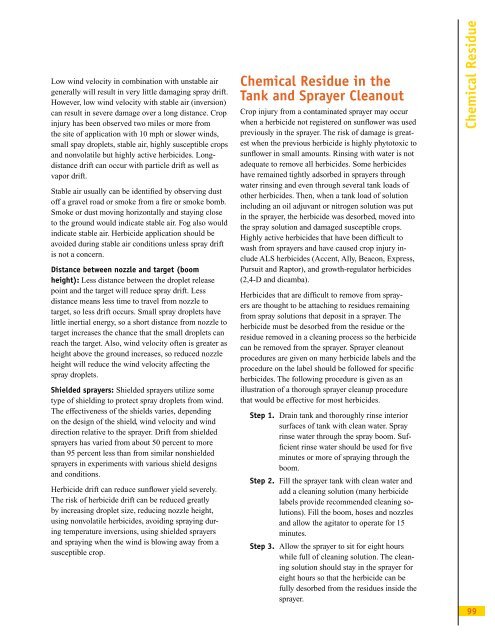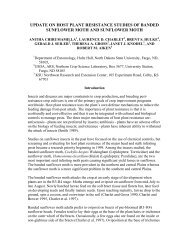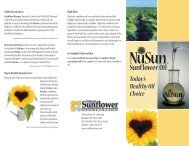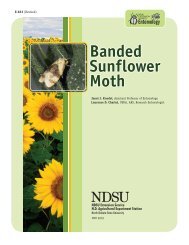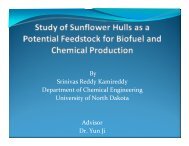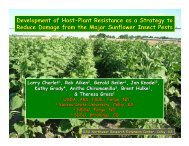Sunflower Production - NDSU Agriculture - North Dakota State ...
Sunflower Production - NDSU Agriculture - North Dakota State ...
Sunflower Production - NDSU Agriculture - North Dakota State ...
You also want an ePaper? Increase the reach of your titles
YUMPU automatically turns print PDFs into web optimized ePapers that Google loves.
Low wind velocity in combination with unstable airgenerally will result in very little damaging spray drift.However, low wind velocity with stable air (inversion)can result in severe damage over a long distance. Cropinjury has been observed two miles or more fromthe site of application with 10 mph or slower winds,small spay droplets, stable air, highly susceptible cropsand nonvolatile but highly active herbicides. Longdistancedrift can occur with particle drift as well asvapor drift.Stable air usually can be identified by observing dustoff a gravel road or smoke from a fire or smoke bomb.Smoke or dust moving horizontally and staying closeto the ground would indicate stable air. Fog also wouldindicate stable air. Herbicide application should beavoided during stable air conditions unless spray driftis not a concern.Distance between nozzle and target (boomheight): Less distance between the droplet releasepoint and the target will reduce spray drift. Lessdistance means less time to travel from nozzle totarget, so less drift occurs. Small spray droplets havelittle inertial energy, so a short distance from nozzle totarget increases the chance that the small droplets canreach the target. Also, wind velocity often is greater asheight above the ground increases, so reduced nozzleheight will reduce the wind velocity affecting thespray droplets.Shielded sprayers: Shielded sprayers utilize sometype of shielding to protect spray droplets from wind.The effectiveness of the shields varies, dependingon the design of the shield, wind velocity and winddirection relative to the sprayer. Drift from shieldedsprayers has varied from about 50 percent to morethan 95 percent less than from similar nonshieldedsprayers in experiments with various shield designsand conditions.Herbicide drift can reduce sunflower yield severely.The risk of herbicide drift can be reduced greatlyby increasing droplet size, reducing nozzle height,using nonvolatile herbicides, avoiding spraying duringtemperature inversions, using shielded sprayersand spraying when the wind is blowing away from asusceptible crop.Chemical Residue in theTank and Sprayer CleanoutCrop injury from a contaminated sprayer may occurwhen a herbicide not registered on sunflower was usedpreviously in the sprayer. The risk of damage is greatestwhen the previous herbicide is highly phytotoxic tosunflower in small amounts. Rinsing with water is notadequate to remove all herbicides. Some herbicideshave remained tightly adsorbed in sprayers throughwater rinsing and even through several tank loads ofother herbicides. Then, when a tank load of solutionincluding an oil adjuvant or nitrogen solution was putin the sprayer, the herbicide was desorbed, moved intothe spray solution and damaged susceptible crops.Highly active herbicides that have been difficult towash from sprayers and have caused crop injury includeALS herbicides (Accent, Ally, Beacon, Express,Pursuit and Raptor), and growth-regulator herbicides(2,4-D and dicamba).Herbicides that are difficult to remove from sprayersare thought to be attaching to residues remainingfrom spray solutions that deposit in a sprayer. Theherbicide must be desorbed from the residue or theresidue removed in a cleaning process so the herbicidecan be removed from the sprayer. Sprayer cleanoutprocedures are given on many herbicide labels and theprocedure on the label should be followed for specificherbicides. The following procedure is given as anillustration of a thorough sprayer cleanup procedurethat would be effective for most herbicides.Step 1. Drain tank and thoroughly rinse interiorsurfaces of tank with clean water. Sprayrinse water through the spray boom. Sufficientrinse water should be used for fiveminutes or more of spraying through theboom.Step 2. Fill the sprayer tank with clean water andadd a cleaning solution (many herbicidelabels provide recommended cleaning solutions).Fill the boom, hoses and nozzlesand allow the agitator to operate for 15minutes.Step 3. Allow the sprayer to sit for eight hourswhile full of cleaning solution. The cleaningsolution should stay in the sprayer foreight hours so that the herbicide can befully desorbed from the residues inside thesprayer.Chemical Residue99


